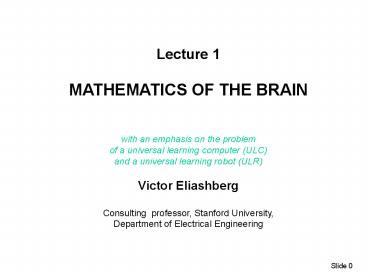MATHEMATICS OF THE BRAIN - PowerPoint PPT Presentation
1 / 32
Title:
MATHEMATICS OF THE BRAIN
Description:
In psychological terms PROM can be thought of as a Long-Term Memory (LTM) ... 4,000 inner hair cells ~12,000 outer hair cells ~30,000 fibers ~90,000 cells ~390, ... – PowerPoint PPT presentation
Number of Views:160
Avg rating:3.0/5.0
Title: MATHEMATICS OF THE BRAIN
1
Lecture 1 MATHEMATICS OF THE BRAIN with an
emphasis on the problem of a universal learning
computer (ULC) and a universal learning robot
(ULR) Victor Eliashberg Consulting professor,
Stanford University, Department of Electrical
Engineering
Slide 0
2
WHAT DOES IT MEAN TO UNDERSTAND THE BRAIN?
1. User understanding.
2. Repairman understanding.
3. Programmer (educator) understanding.
4. Systems developer understanding.
5. Salesman understanding.
Slide 1
3
TWO MAIN APPROACHES
1. BIOLOGICALLY-INSPIRED ENGINEERING (bionics)
Formulate biologically-inspired engineering /
mathematical problems. Try to solve these
problems in the most efficient engineering way.
This approach had big success in engineering
universal programmable computer vs. human
computer , a car vs. a horse, an airplane vs. a
bird. It hasnt met with similar success in
simulating human cognitive functions.
2. SCIENTIFIC / ENGINEERING (reverse engineering
hacking)
Formulate biologically-inspired engineering or
mathematical hypotheses. Study the implications
of these hypotheses and try to falsify the
hypotheses. That is, try to eliminate
biologically impossible ideas! We believe this
approach has a better chance to succeed in the
area of brain-like computers and intelligent
robots than the first one. Why? So far the
attempts to define the concepts of learning and
intelligence per se as engineering/mathematical
concepts have led to less interesting problems
than the original biological problems.
Slide 2
4
HUMAN ROBOT
Slide 3
5
CONTROL SYSTEM
Slide 4
6
OUR MOST IMPORTANT PERSONAL COMPUTER
12 cranial nerves 1010 neurons in each
hemisphere
1011 neurons
31 pairs of nerves 107 neurons
8 pairs
12 pairs
5 pairs
6 pairs
Slide 5
7
The brain has a very large but topologically
simple circuitry
The shown cerebellar network has 1011 granule
(Gr) cells and 2.5 107 Purkinje (Pr) cells.
There are around 105 synapses between T-shaped
axons of Gr cells and the dendrites of a single
Pr cell.
Pr
Memory is stored in such matrices
Slide 6
LTM size
Cerebelum N2,5 107 105 2.51012 B 2.5 TB.
Neocortex N1010 104 1014 B 100 TB.
8
Big picture Cognitive system (Robot,World)
External system (W,D)
Computing system, B, simulating the work of human
nervous system
Sensorimotor devices, D
B
D
W
Human-like robot (D,B)
External world, W
B(t) is a formal representation of B at time t,
where t0 is the beginning of learning. B(0) is
an untrained brain. B(0)(H(0),g(0)),
where H(0) H is the representation of the
brain hardware, g(0) is the representation of
initial knowledge (state of LTM)
Slide 7
9
CONCEPT OF FORCED MOTOR TRAINING
Brain (NS,NM,AM)
External system (W,D)
D
AM
S
NS
Motor control
W
associations
M
NM
Teacher
During training, motor signals (M) can be
controlled byTeacher or by learner (AM) .
Sensory signals (S) are received from external
system (W,D).
.
Slide 8
10
Turings machine as a system (Robot, World)
Slide9
11
TWO TYPES OF LEARNING
Slide 10
12
Mental computations (thinking) as an interaction
between motor control and working memory
(EROBOT.EXE)
Slide 11
13
Motor and sensory areas of the neocortex
14
Primary sensory and motor areas, association areas
Slide 13
15
Association fibers (neural busses)
Slide 14
16
SYSTEM-THEORETICAL BACKGROUND
Slide 15
17
Fundamental constraint associated with the
general levels of computing power
Traditional ANN models are below the red line.
Symbolic systems go above the red line but they
require a read/write memory buffer. The brain
doesnt have such buffer.
Fundamental problem How can the human brain
achieve the highest level of computing power
without a memory buffer?
Slide 16
18
General structure of universal programmable
systems of different types
PROM stands for Programmable Read-Only Memory.
In psychological terms PROM can be thought of as
a Long-Term Memory (LTM). Letter G implies the
notion of synaptic Gain.
Slide 17
19
Type 3 Finite-state machines
Slide 18
20
Type 0 Turing machines (state machines coupled
with a read/write external memory)
Slide 19
21
Basic arcitecture of a primitive E-machine
Slide 20
22
The brain as a complex E-machine
D
SUBCORTICAL SYSTEMS
SENSORY CORTEX
S1
AS1
ASk
W
D
MOTOR CORTEX
SUBCORTICAL SYSTEMS
M1
AM1
AMm
Slide 21
23
A GLANCE AT THE SENSORIMOTOR DEVICES
Slide 21
24
VISION
Slide 22
25
EYE
Slide 23
26
EYE MOVEMENT CONTOL
Slide 24
27
AUDITORY AND VESTIBULAR SENSORS
Slide 25
28
AUDITORY PREPROCESSING
100,000,000 cells
580,000 cells
4,000 inner hair cells 12,000 outer hair cells
390,000 cells
90,000 cells
30,000 fibers
Slide 26
29
OTHER STUFF
Slide 27
30
EMOTIONS (1)
Slide 28
31
EMOTIONS (2)
Slide 29
32
SPINAL MOTOR CONTROL
SENSORY FIBERS
MOTOR FIBERS
Slide 30






![Download Book [PDF] Brain Teaser Interview Questions PowerPoint PPT Presentation](https://s3.amazonaws.com/images.powershow.com/10061296.th0.jpg?_=20240621086)
























